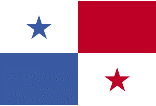|
Panama
|

|
Capital: Panama
Population: 4,246,439
Brief History of Panama:
Panama was originally inhabited by the Native American tribes of the Cocle and Cuevas peoples. The first European to visit Panama was Rodrigo de Bastida in 1501. A year later, Christopher Columbus arrived and established the city of Darien.
In 1513 Vasco de Balboa made his famous trek from the Atlantic Ocean to the Pacific across the Isthmus of Panama. This trip proved that the crossing could be made and turned Panama in to a major trading center. For years silver and gold was shipped in from other areas in the New World, carried across Panama, and then put on ships bound for Spain. The trip was dangerous and the road across Panama gained the nickname the Camino de Cruces or Road of the Crosses due to all the people who died along the way.
For nearly 300 years Panama was a colony of the Spanish Empire. In 1821 Panama left the Spanish Empire and became a part of Colombia. Over the years Panama tried to leave Colombia but was unable to. In 1903 Panama finally declared independence and signed a treaty with the United States. The treaty stated that the United States would have rights to a zone 10 miles wide and 50 miles long where it would build a canal to be used to cross Panama. In 1914 the United States completed the Panama Canal. In 1999 the canal was passed into the hands of the Panamanian government.
The Geography of Panama
Total Size: 78,200 square km
Size Comparison: slightly smaller than South Carolina
Geographical Coordinates: 9 00 N, 80 00 W
World Region or Continent: Central America
General Terrain: interior mostly steep, rugged mountains and dissected, upland plains; coastal areas largely plains and rolling hills
Geographical Low Point: Pacific Ocean 0 m
Geographical High Point: Volcan de Chiriqui 3,475 m
Climate: tropical maritime; hot, humid, cloudy; prolonged rainy season (May to January), short dry season (January to May)
Major cities: PANAMA CITY (capital) 1.346 million (2009)
The People of Panama
Type of Government: constitutional democracy
Languages Spoken: Spanish (official), English 14%; note - many Panamanians bilingual
Independence: 3 November 1903 (from Colombia; became independent from Spain 28 November 1821)
National Holiday: Independence Day, 3 November (1903)
Nationality: Panamanian(s)
Religions: Roman Catholic 85%, Protestant 15%
National Symbol: harpy eagle
National Anthem or Song: Himno Istemno (Isthmus Hymn)
Economy of Panama
Major Industries: construction, brewing, cement and other construction materials, sugar milling
Agricultural Products: bananas, rice, corn, coffee, sugarcane, vegetables; livestock; shrimp
Natural Resources: copper, mahogany forests, shrimp, hydropower
Major Exports: bananas, shrimp, sugar, coffee, clothing
Major Imports: capital goods, foodstuffs, consumer goods, chemicals
Currency: balboa (PAB); US dollar (USD)
National GDP: $50,610,000,000
** Source for population (2012 est.) and GDP (2011 est.) is CIA World Factbook.
Back to Geography Home Page
